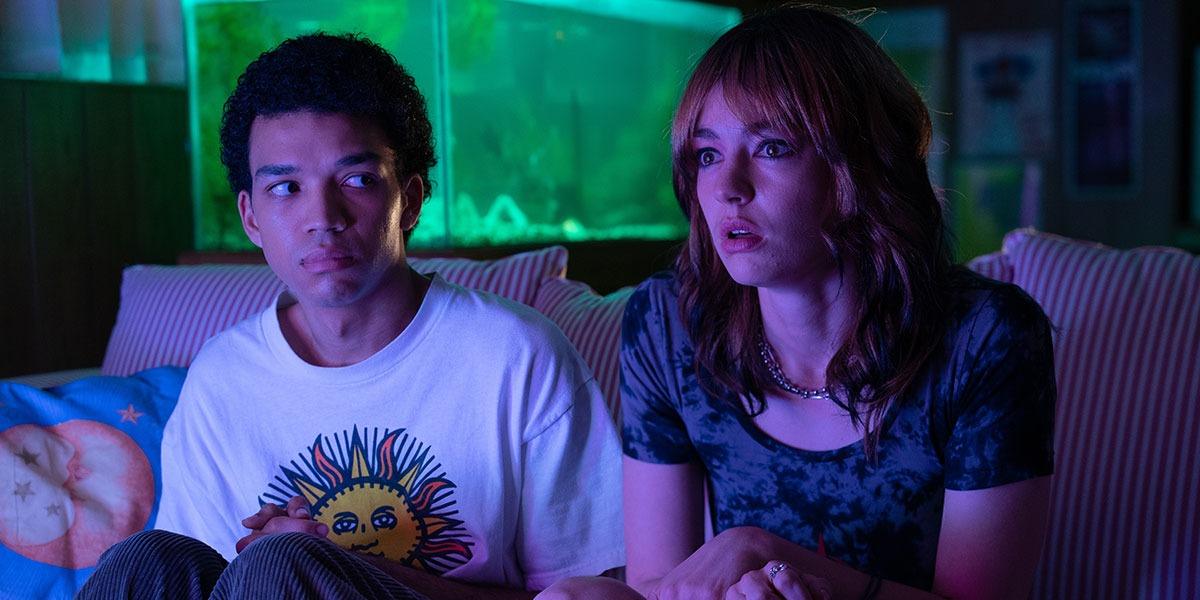I Saw the TV Glow
Content Advisory: Ableism, Homophobia
Two friends begin to question their reality after their favourite television show is cancelled in I Saw the TV Glow. In 1996, isolated seventh grader Owen (Ian Foreman) meets lesbian ninth grader Maddy (Brigette Lundy-Paine). The two end up bonding over their mutual love of a young adult horror series called The Pink Opaque, following the adventures of psychic friends Isabel (Helena Howard) and Tara (Lindsey Jordan) as they fight monsters unleashed by the lunar villain Mr. Melancholy (Emma Portner).
One day Maddy vanishes without a trace and the now-older Owen (Justice Smith) has to deal with the death of his mother Brenda (Danielle Deadwyler) and his cruel father Frank (Fred Durst). Nearly a decade passes and Owen finds himself working a dead-end job in a movie theatre. However, Maddy suddenly reemerges with the news that their reality might not be what it seems.

I Saw the TV Glow Synopsis
I Saw the TV Glow is a horror-adjacent drama written and directed by Jane Schoenbrun (We’re All Going to the World’s Fair). The film stars Justice Smith (Dungeons and Dragons: Honor Among Thieves) and Brigette Lundy-Paine (Bill and Ted Face the Music) as two outcast friends, Owen and Maddy, who bond over a young adult horror series called The Pink Opaque. While Owen is an introverted, and quite possibly autistic, young man, he finds himself drawn into the world of The Pink Opaque, even answering “I Like TV” when questioned by Maddy whether he likes girls or boys.
However, Maddy disappears one night without a trace, with her TV seen burning in the yard. The Pink Opaque is cancelled soon afterwards and Owen finds himself without a sense of direction in his life. Eight years pass and suddenly Owen comes across Maddy in the grocery store, where she reveals some surprising facts about where she’s been.
My Thoughts on I Saw the TV Glow
For their sophomore feature film, non-binary trans filmmaker Jane Schoenbrun uses nostalgia for 1990s young adult horror TV shows, such as Eerie, Indiana, Are You Afraid of the Dark, and Buffy the Vampire Slayer to give an allegory for gender identity and dysphoria. To say how I Saw the TV Glow does so is a bit of a spoiler. However, I can say that it involves the lack of direction that Justice Smith’s character of Owen feels in his life after the cancellation of the Pink Opaque TV show.
As someone who grew up watching many of the young adult horror shows I Saw the TV Glow is influenced by, I enjoyed the attention to detail used to create the show-within-the-film The Pink Opaque, which includes a grainy VHS feel and monsters in garish practical make-up, nearly all of which are portrayed by Canadian dancer Emma Portner. There is even one scene in the film, where Owen re-watches The Pink Opaque on streaming, which comments on how we tend to view nostalgia through rose-coloured glasses.
Arguably the biggest issue I have with I Saw the TV Glow is the lead performance by Justice Smith as Owen. At best, I would describe Owen as being vaguely autistic, speaking in a monotone voice and at one point being unable to look at his bullying movie theatre manager in the eye. It is also insinuated that Owen’s autism makes him asexual, and more interested in the TV show The Pink Opaque than any meaningful romantic connection. While this does somewhat play a role in how the plot progresses, it does not sit too well with an autistic person such as myself.
The more impressive performance of I Saw the TV Glow goes to Brigette Lundy-Paine as Maddy. In particular, Maddy gives a lengthy monologue towards the end of the film’s second act, which ends up greatly summing up the themes of I Saw the TV Glow. In an odd bit of stunt casting, Fred Durst of the nu-metal band Limp Bizkit plays Owen’s cruel father, Frank, though he ends up having barely any lines, instead just giving imposing looks. The film also features a brief cameo by Amber Benson, best known for playing Tara Maclay on Buffy the Vampire Slayer.
I also have to make note of the quite impressive soundtrack for I Saw the TV Glow, described by Jane Schoenbrun as the “greatest ’90s mixtape that didn’t exist yet”. This includes Singaporean singer Yeule doing a cover of Canadian indie rock band Broken Social Scene‘s 2002 song “Anthems for a Seventeen Year-Old Girl,” which bookends the film. I Saw the TV Glow also features a cover of Smashing Pumpkins’ 1996 single “Tonight Tonight,” as well as a scene featuring live performances by Sloppy Jane feat. Phoebe Bridgers and King Woman.
Admittedly, I Saw the TV Glow is probably going to polarize some viewers expecting the film to be more explicitly horror than it turns out to be. However, the film still ends up being a solid slice of 1990s nostalgia, while also working as an allegory for the trans experience. I just wish Justice Smith’s character was less offensively autistic.


 Get ready for a vibrant and fun-filled painting experience with Splatter Painting in Toronto!
Get ready for a vibrant and fun-filled painting experience with Splatter Painting in Toronto!  Unleash your creativity with an energetic splatter painting session
Unleash your creativity with an energetic splatter painting session 